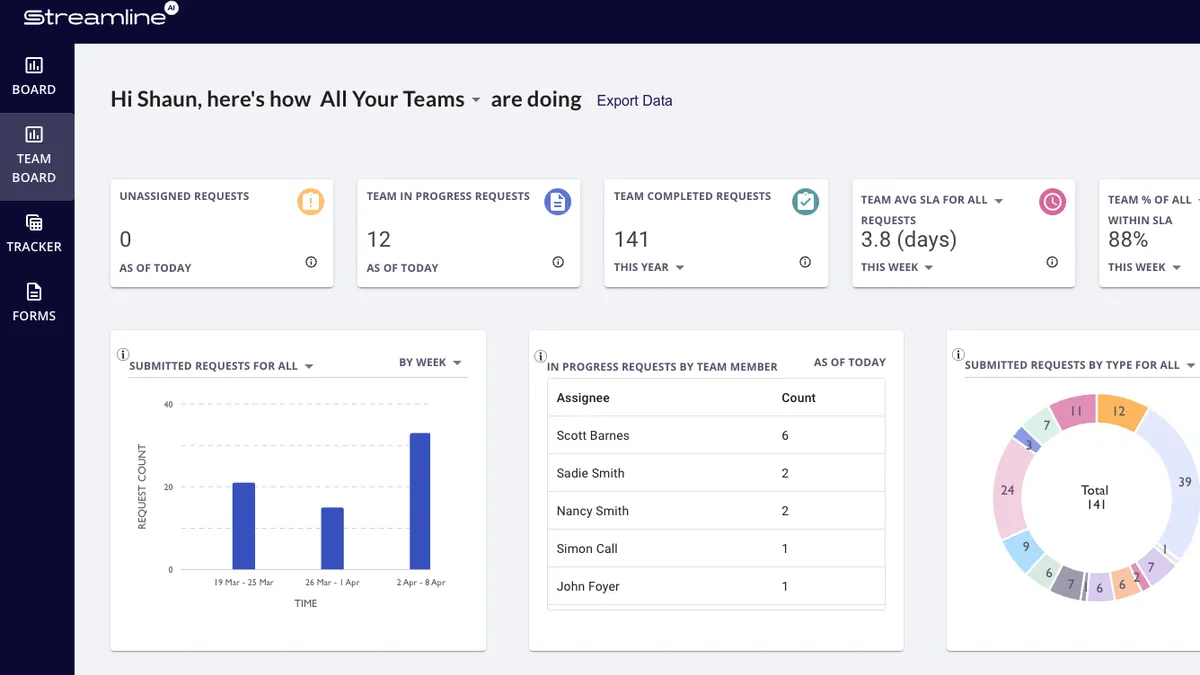As a former associate general counsel at DoorDash, Kathy Zhu knows firsthand how difficult it can be for in-house counsel to complete work without frequently being interrupted by requests for legal help.
She said these requests typically come from many different avenues, including emails, Slack messages and even business colleagues dropping by the legal department.
Additionally, once a legal professional begins working on a task, coworkers from other teams will often seek status updates because they have little visibility into Legal’s workflows.
Zhu said a software platform she co-founded called Streamline AI aims to address these issues by using technology to improve the intake process and automate key workflows for in-house legal teams.
The AI-powered platform also provides transparency about the legal department’s work to members of other business units and generates a variety of actionable metrics.
“Based on my experience at DoorDash and prior roles, I realized that there was a gap in the market for a technology solution that helps in-house teams to handle the intake of large volumes of legal requests beyond contracts, get visibility into the work flowing into their team and access much needed metrics to make data-driven decisions,” Zhu said.
Zhu, who also worked in-house at Medallia, is Streamline AI’s CEO and GC. She co-founded the company with Julian Wimbush, a former Google product lead and AI expert.
They started selling the legal process management platform to customers in 2021, and the company announced a $3 million seed funding round as part of their media launch in November 2022.
Zhu recently spoke with Legal Dive about how the technology can help legal teams improve their operational efficiency and collaborate more effectively with other business units.
Intake
Zhu said Streamline AI starts by helping in-house legal teams more efficiently manage the various high-volume requests they receive for their legal counsel from colleagues in other departments.
These requests can range from privacy issues to contractor onboarding to marketing compliance.
The platform’s integration with tools such as Gmail, Slack and Salesforce, among others, allows business team members to use those platforms to submit their requests.
The requests are then automatically pulled into Streamline AI and listed in a dashboard where legal department members can view them and begin to triage.
The dashboard includes information such as when a request was submitted, who submitted it and the person in the legal department who will oversee the matter.
The dashboard also lists the status of the request—including whether Legal is waiting for another team to take action—and a full audit trail of the approvals, comments, and actions taken on the request to date.
Zhu said Streamline AI’s intake process is a major improvement from the approach many legal teams take of having a team member manually update a spreadsheet every time a request is received and use different systems to track relevant request-related information.
Workflows
Legal teams can also utilize Streamline AI to set up no-code workflows that lay out how a task should be handled following the receipt of a request for assistance.

Vendor purchasing is one of the common workflows legal teams are using Streamline AI to set up, Zhu said.
For example, if an outside vendor will have access to personally identifiable information (PII), a legal team can create a workflow so that Streamline AI automatically notifies the privacy and information security teams. These teams can also be required to give an approval in order for the workflow to move to the next stages of the process.
Other legal teams are using Streamline AI for sales-related workflows, which can be kicked off by the sales team sending over a request via Salesforce.
Zhu said in-house teams can set up Streamline AI so that if there are certain non-standard terms in a sales contract, the accounting team would be automatically looped in to provide approval.
“The legal team determines how they want these workflows to be built,” Zhu said. “It's extremely intuitive, and that's the secret sauce. You don't need code. You don't need anything complicated. It's all Plain English.”
Transparency
Meanwhile, Zhu said Streamline AI can also help solve the issue of business units having very little visibility into the work of legal departments, which she calls Legal’s “black box” problem.
One way legal teams can use the technology to provide greater transparency about their efforts is by adding business colleagues as “followers” on specific tasks.
For example, Zhu said a VP of sales could be automatically added as a follower on significant sales deals above a certain dollar threshold.
Adding someone as a follower permits them to see which approvals are still needed on a task, as well as what other steps are still to be completed. The followers can also receive notifications as a request moves through the necessary steps.
“One of the most annoying things is having to constantly keep leadership updated on key deals and projects while maintaining tight turnaround times when the pressure mounts,” Zhu said. “Streamline can keep stakeholders updated on Legal’s behalf, via Slack, Salesforce or email.”
Turnaround times
Streamline AI also allows in-house legal teams to track key metrics that they can review internally and share with other business units.
For example, there is an SLA tracker that shows how long it took Legal to complete tasks on a specific request.
The tracker turns off when the legal team is waiting on the requester or another non-legal team member to take steps before the task returns to Legal.
“This is really, really important for legal teams because often business teams blame Legal for having these very long lag periods to completion, but it's not even the legal team that’s to blame because the task is not even on Legal’s desk,” Zhu said.
For example, the Streamline AI team discovered that at one company the legal department not being granted permission/access to cloud-based documents resulted in more than 50 days of "waiting on" time as Legal waited for the necessary permissions to come through.
This type of information can allow teams to take responsive action to address the identified problems, Zhu said.
Volume metrics
Another metric legal departments can track in Streamline AI is the volume of requests they receive across different time periods, and they can break these down by matter type.
For example, a legal team could compare the number of sales agreements coming through to Legal in the prior quarter compared to the number of vendor agreements.
This type of data can be useful for discussions about the legal team’s size, according to Zhu.
“One of our customers was able to successfully advocate for incremental additional headcount for the commercial team that they probably otherwise would have struggled to get because they were able to substantiate it with the volume metrics from our platform,” Zhu said.



















